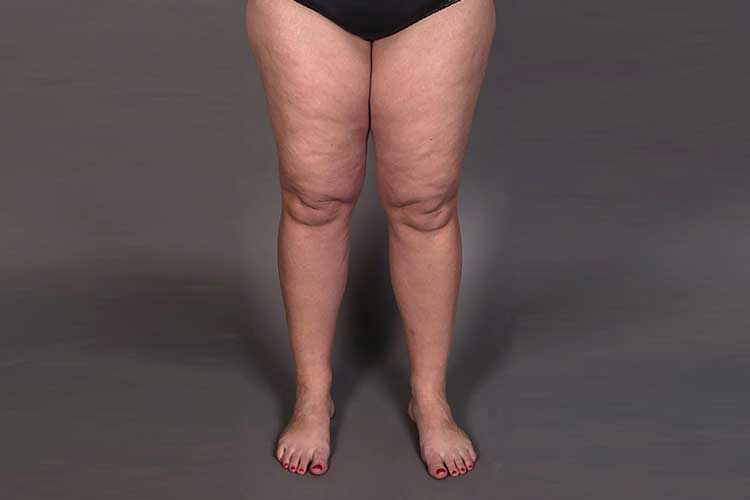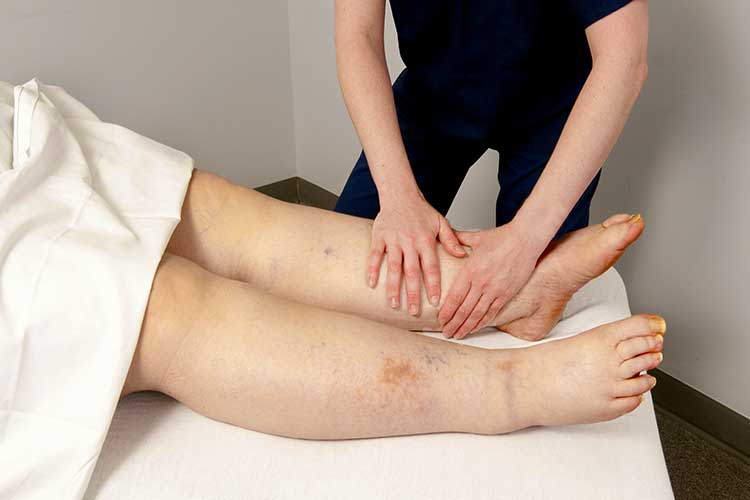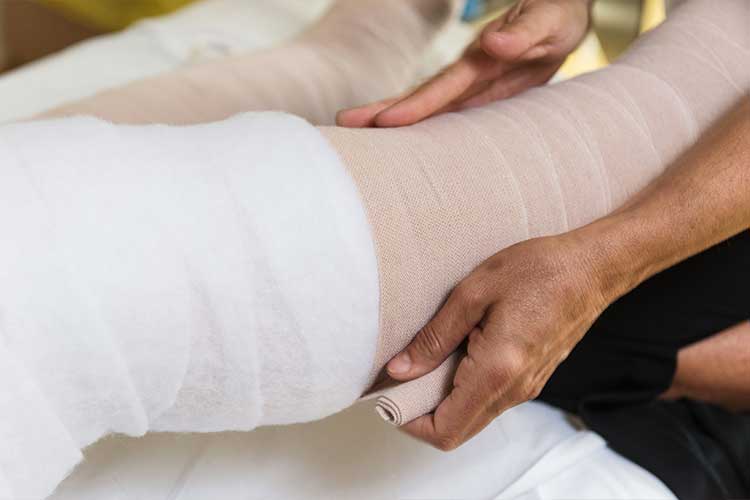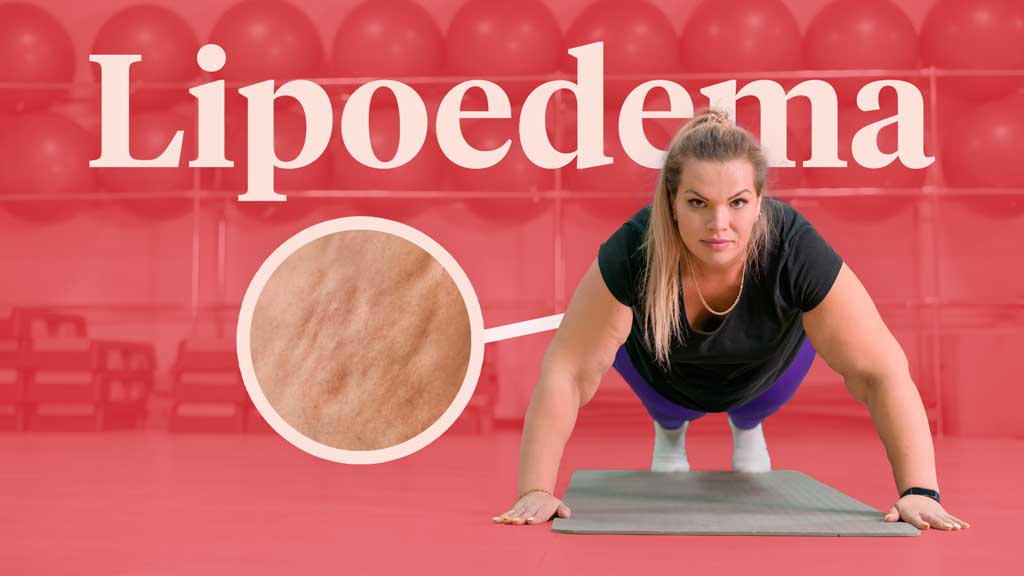Lipoedema is an almost-exclusively female condition estimated to affect around 9% of females in Australia (Oakley et al. 2020; Healthdirect 2023).
In addition to significantly affecting a person’s physical appearance, lipoedema can also cause pain and discomfort that interferes with their daily activities.
What is Lipoedema?

Lipoedema is a chronic progressive condition characterised by an unusual build-up of adipose tissue (fat) under the skin. It predominantly affects women, possibly due to female hormonal changes (Better Health Channel 2023).
In lipoedema, the body's adipose tissue is unevenly distributed, with a disproportionately high amount in the lower extremities compared to the upper body (Better Health Channel 2023; Vyas & Adnan 2023).
This causes a symmetrical accumulation of fat that typically affects the buttocks, thighs, calves, and sometimes the upper arms. The hands and feet do not display swelling (Oakley et al. 2020; Cleveland Clinic 2023).
The condition is often painful, with the affected area being tender, swollen and more likely to bruise (Better Health Channel 2023).
What Causes Lipoedema?
The cause of lipoedema is not fully understood, but it may have a genetic component (Healthdirect 2023).
It’s also thought that the female hormone oestrogen is a contributing factor, as the onset of lipoedema tends to occur during periods of hormonal shift: puberty, pregnancy and menopause (Oakley et al. 2020; Better Health Channel 2023). Further supporting this theory is the fact that the few men who develop lipoedema often have liver disease or low testosterone - both of which are associated with high levels of oestrogen (Vyas & Adnan 2023).
Lipoedema is unrelated to obesity or weight gain and can affect people of all body types (Better Health Channel 2023).
Lipoedema v Lymphoedema
Despite the similarities in name, lipoedema and lymphoedema are separate conditions.
Both conditions can result in a similar body appearance, however, while lipoedema is an excessive accumulation of fat, lymphoedema is an excessive build-up of fluid caused by a blockage in the lymphatic system (Better Health Channel 2023).
Lymphoedema can be primary or secondary, and in some cases may actually be secondary to lipoedema if the excessive adipose tissue compresses the lymphatic tracts/vessels and causes an obstruction (Better Health Channel 2023).
Key differences between lipoedema and lymphoedema include the following:
- Unlike lipoedema, lymphoedema affects the hands and feet
- Lymphoedema causes symmetrical swelling, while lymphoedema causes asymmetrical swelling
- Short-term lymphoedema causes pitting or indentation, while lipoedema does not
- Those with lymphoedema are at greater risk of infection than those with lipoedema.
(Better Health Channel 2023)

Symptoms of Lipoedema
Those with lipoedema might experience:
- Symmetrical swelling on the legs, usually between the hips and ankles
- A column-like appearance of the legs
- Spongy, soft and cool skin in the affected areas
- Dimpled ‘orange peel’ texture in the affected areas
- Tenderness and easy bruising in the affected areas
- Varicose or spider veins in the affected areas
- Sensitivity in the affected areas
- Pain, heaviness and discomfort in the affected areas, especially in the afternoon or evening, after physical activity or in hot weather
- Difficulty walking or performing physical activity, exercise or daily tasks
- Low self-esteem, anxiety or restricted social life due to symptoms and altered physical appearance
- Difficulty buying clothes that fit due to the difference in size between the upper and lower body.
(Better Health Channel 2023)
Stages of Lipoedema
As lipoedema is a progressive condition, the accumulation of adipose tissue usually increases over time (Cleveland Clinic 2023).
Lipoedema can be categorised into one of four stages depending on how much the condition has progressed. However, note that these stages are based solely on the appearance of the skin and do not take into account the patient’s symptoms, pain, functional capacity and quality of life (Lipedema Foundation 2019; Oakley et al. 2020).
| Stage 1 | Skin is smooth and appears normal, but small nodules of adipose tissue can be palpated. |
| Stage 2 | Skin surface is uneven, and larger nodules of adipose tissue can be seen and palpated. |
| Stage 3 | Nodules of adipose tissue become large and disfiguring, particularly around the knees and thighs. The legs may appear column-like with large folds of skin and fat. Joints, mobility and balance may be impaired. |
| Stage 4 | Development of lipo-lymphoedema (presence of both lipoedema and lymphoedema) and large overhangs of tissue on the legs and arms.. |
(Lipedema Foundation 2019; Oakley et al. 2020; Vyas & Adnan 2023; Lipedema Medical Solutions 2022)
Diagnosing Lipoedema
Lipoedema may be diagnosed through a combination of the following:
- Physical examination
- Patient history, assessing:
- Age of symptom onset
- Signs and symptoms of the swelling
- Tissue sensitivity
- Tendency to develop swelling when standing
- Weight gain
- Stress
- Assessment of any complications associated with lipoedema (skin irritation, impaired gait, secondary lymphoedema)
- Imaging (ultrasound, colour duplex ultrasonography, CT scan, MRI).
(Better Health Channel 2023; Oakley et al. 2020)
There are a variety of differential diagnoses that may need to be excluded, including:
- Lymphoedema
- Obesity
- Phleboedema and chronic venous insufficiency
- Lipohypertrophy
- Lipomatosis
- Myxoedema.
(Oakley et al. 2020)
Treating Lipoedema

Treatment and management strategies for lipoedema include:
- Maintaining a healthy diet to reduce non-lipoedemic fat and inflammation
- Using compression bandages
- Performing skincare (e.g. using moisturising creams to prevent dryness)
- Wearing loose, comfortable clothing and avoiding tight belts or bras
- Exercising to increase mobility and circulation
- Massage to improve mobility and shift fluids from the affected area
- Liposuction followed by compression.
(Better Health Channel 2023; medi Australia 2015)
Test Your Knowledge
Question 1 of 3
True or false: Lipoedema can cause lymphoedema.
Topics
References
- Better Health Channel 2023, Lipoedema, Victoria State Government, viewed 11 March 2025, https://www.betterhealth.vic.gov.au/health/conditionsandtreatments/Lipoedema
- Cleveland Clinic 2023, Lipedema, Cleveland Clinic, viewed 11 March 2025, https://my.clevelandclinic.org/health/diseases/17175-lipedema
- Healthdirect 2023, Lipoedema, Australian Government, viewed 11 March 2025, https://www.healthdirect.gov.au/lipoedema
- Lipedema Foundation 2019, Staging of Lipedema, Lipedema Foundation, viewed 11 March 2025, https://www.lipedema.org/staging
- Lipedema Medical Solutions 2022, Stages & Types of Lipedema, Lipedema Medical Solutions, viewed 11 March 2025, https://www.lipedema.net/lipedemastages.html
- medi Australia 2015, Lipoedema, medi Australia, viewed 11 March 2025, https://www.mediaustralia.com.au/health/diagnosis-therapy/lipoedema/
- Oakley, A, Baumgartner, A & Mitchell, G 2020, Lipoedema – Definition and Pathogenesis, DermNet, viewed 11 March 2025, https://dermnetnz.org/topics/lipoedema-definition-and-pathogenesis
- Vyas, A & Adnan, G 2023, ‘Lipedema’, StatPearls, viewed 11 March 2025, https://www.ncbi.nlm.nih.gov/books/NBK573066/
 New
New 
